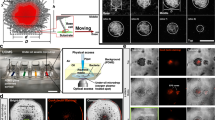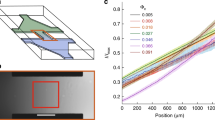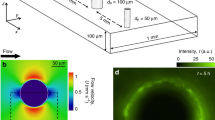Abstract
The motion of peritrichously flagellated bacteria close to surfaces is relevant to understanding the early stages of biofilm formation and of pathogenic infection1,2,3,4. This motion differs from the random-walk trajectories5 of cells in free solution. Individual Escherichia coli cells swim in clockwise, circular trajectories near planar glass surfaces6,7. On a semi-solid agar substrate, cells differentiate into an elongated, hyperflagellated phenotype and migrate cooperatively over the surface8, a phenomenon called swarming. We have developed a technique for observing isolated E. coli swarmer cells9 moving on an agar substrate and confined in shallow, oxidized poly(dimethylsiloxane) (PDMS) microchannels. Here we show that cells in these microchannels preferentially ‘drive on the right’, swimming preferentially along the right wall of the microchannel (viewed from behind the moving cell, with the agar on the bottom). We propose that when cells are confined between two interfaces—one an agar gel and the second PDMS—they swim closer to the agar surface than to the PDMS surface (and for much longer periods of time), leading to the preferential movement on the right of the microchannel. Thus, the choice of materials guides the motion of cells in microchannels.
This is a preview of subscription content, access via your institution
Access options
Subscribe to this journal
Receive 51 print issues and online access
$199.00 per year
only $3.90 per issue
Buy this article
- Purchase on Springer Link
- Instant access to full article PDF
Prices may be subject to local taxes which are calculated during checkout




Similar content being viewed by others
References
Pratt, L. A. & Kolter, R. Genetic analysis of Escherichia coli biofilm formation: Roles of flagella, motility, chemotaxis and type I pili. Mol. Microbiol. 30, 285–293 (1998)
Harshey, R. M. Bacterial motility on a surface: Many ways to a common goal. Annu. Rev. Microbiol. 57, 249–273 (2003)
Ottemann, K. M. & Miller, J. F. Roles for motility in bacterial–host interactions. Mol. Microbiol. 24, 1109–1117 (1997)
Vigeant, M. A. S., Ford, R. M., Wagner, M. & Tamm, L. K. Reversible and irreversible adhesion of motile Escherichia coli cells analyzed by total internal reflection aqueous fluorescence microscopy. Appl. Environ. Microbiol. 68, 2794–2801 (2002)
Berg, H. C. & Brown, D. A. Chemotaxis in Escherichia coli analyzed by three-dimensional tracking. Nature 239, 500–504 (1972)
Berg, H. C. & Turner, L. Chemotaxis of bacteria in glass-capillary arrays. Biophys. J. 58, 919–930 (1990)
Frymier, P. D., Ford, R. M., Berg, H. C. & Cummings, P. T. Three-dimensional tracking of motile bacteria near a solid planar surface. Proc. Natl Acad. Sci. USA 92, 6195–6199 (1995)
Henrichsen, J. Bacterial surface translocation: A survey and classification. Bacteriol. Rev. 36, 478–503 (1972)
Harshey, R. M. & Matsuyama, T. Dimorphic transition in Escherichia coli and Salmonella typhimurium—surface-induced differentiation into hyperflagellate swarmer cells. Proc. Natl Acad. Sci. USA 91, 8631–8635 (1994)
Berg, H. C. & Anderson, R. A. Bacteria swim by rotating their flagellar filaments. Nature 245, 380–382 (1973)
Berg, H. C. The rotary motor of bacterial flagella. Annu. Rev. Biochem. 72, 19–54 (2003)
Turner, L., Ryu, W. S. & Berg, H. C. Real-time imaging of fluorescent flagellar filaments. J. Bacteriol. 182, 2793–2801 (2000)
Taylor, G. The action of waving cylindrical tails in propelling microscopic organisms. Proc. R. Soc. Lond. A 211, 225–239 (1952)
Ramia, M., Tullock, D. L. & Phan-Thien, N. The role of hydrodynamic interaction in the locomotion of microorganisms. Biophys. J. 65, 755–778 (1993)
Vigeant, M. A. S. & Ford, R. M. Interactions between motile Escherichia coli and glass in media with various ionic strengths, as observed with a three- dimensional-tracking microscope. Appl. Environ. Microbiol. 63, 3474–3479 (1997)
Xia, Y. & Whitesides, G. M. Soft lithography. Angew. Chem. Int. Edn Engl. 37, 550–575 (1998)
Brandrup, J., Immergut, E. H. & Grulke, E. A. (eds) Polymer Handbook, 4th edn (Wiley, New York, 1999)
Toguchi, A., Siano, M., Burkart, M. & Harshey, R. M. Genetics of swarming motility in Salmonella enterica Serovar Typhimurium: Critical role for lipopolysaccharide. J. Bacteriol. 182, 6308–6321 (2000)
Frymier, P. D. & Ford, R. M. Analysis of bacterial swimming speed approaching a solid–liquid interface. AIChE J. 43, 1341–1347 (1997)
Biondi, S. A., Quinn, J. A. & Goldfine, H. Random motility of swimming bacteria in restricted geometries. AIChE J. 44, 1923–1929 (1998)
Pernodet, N., Maaloum, M. & Tinland, B. Pore size of agarose gels by atomic force microscopy. Electrophoresis 18, 55–58 (1997)
Damiano, E. R., Long, D. S., El-Khatib, F. H. & Stace, T. M. On the motion of a sphere in a Stokes flow parallel to a Brinkman half-space. J. Fluid Mech. 500, 75–101 (2004)
Allison, C., Lai, H. C. & Hughes, C. Coordinate expression of virulence genes during swarm-cell differentiation and population migration of Proteus mirabilis. Mol. Microbiol. 6, 1583–1591 (1992)
Visick, K. L. & McFall-Ngai, M. J. An exclusive contract: Specificity in the Vibrio fischeri Euprymna scolopes partnership. J. Bacteriol. 182, 1779–1787 (2000)
Darnton, N., Turner, L., Breuer, K. & Berg, H. C. Moving fluid with bacterial carpets. Biophys. J. 86, 1863–1870 (2004)
Armstrong, J. B., Adler, J. & Dahl, M. M. Nonchemotactic mutants of Escherichia coli. J. Bacteriol. 93, 390–398 (1967)
Wolfe, A. J., Conley, M. P., Kramer, T. J. & Berg, H. C. Reconstitution of signalling in bacterial chemotaxis. J. Bacteriol. 169, 1878–1885 (1987)
Parkinson, J. S. Complementation analysis and deletion mapping of Escherichia coli mutants defective in chemotaxis. J. Bacteriol. 135, 45–53 (1978)
Acknowledgements
We thank W. S. Ryu, D. Ryan, M. P. Brenner and H. A. Stone for discussions, and S. Rojevskaya for technical assistance. This research was supported by the NIH and DOE. W.R.D. acknowledges an NSF-IGERT Biomechanics Training Grant. M.M. acknowledges a postdoctoral fellowship from the Swiss National Science Foundation. P.G. thanks the Foundation for Polish Science for a postdoctoral fellowship. D.B.W. thanks the NIH for a postdoctoral fellowship.
Author information
Authors and Affiliations
Corresponding author
Ethics declarations
Competing interests
Reprints and permissions information is available at npg.nature.com/reprintsandpermissions. The authors declare no competing financial interests.
Supplementary information
Supplementary Data
Results from experiments where the surfactant and ionic strength of the motility agar was varied, presented in Supplementary Table S1, and histograms of the lengths and speeds of cells traveling along the right and left channel wall. (DOC 311 kb)
Supplementary Methods
Methods used to grow swarmer cells, the preparation of PDMS films, image acquisition and data analysis, the fabrication of silicon masters, and the preparation of GFP-cells. (DOC 29 kb)
Supplementary Video S1
Real-time movement to the right of E. coli swarmer cells (AW405) in composite agar/PDMS microchannels that are 10 m wide and 1.4 µm tall. Nutrient agar forms the floor of the channel and a patterned PDMS film forms the sidewalls and ceiling. (MPG 975 kb)
Supplementary Video S2
Real-time movement to the right of E. coli swarmer cells (AW405) in composite agar/PDMS microchannels that are 3 m wide and 1.4 µm tall. Nutrient agar forms the floor of the channel and a patterned PDMS film forms the sidewalls and ceiling. (MPG 808 kb)
Rights and permissions
About this article
Cite this article
DiLuzio, W., Turner, L., Mayer, M. et al. Escherichia coli swim on the right-hand side. Nature 435, 1271–1274 (2005). https://doi.org/10.1038/nature03660
Received:
Accepted:
Issue Date:
DOI: https://doi.org/10.1038/nature03660
This article is cited by
-
Nature-inspired micropatterns
Nature Reviews Methods Primers (2023)
-
Human sperm cooperate to transit highly viscous regions on the competitive pathway to fertilization
Communications Biology (2023)
-
Motility-induced phase separation is reentrant
Communications Physics (2023)
-
Bioinspired chiral inorganic nanomaterials
Nature Reviews Bioengineering (2023)
-
A virtual reality interface for the immersive manipulation of live microscopic systems
Scientific Reports (2021)
Comments
By submitting a comment you agree to abide by our Terms and Community Guidelines. If you find something abusive or that does not comply with our terms or guidelines please flag it as inappropriate.



